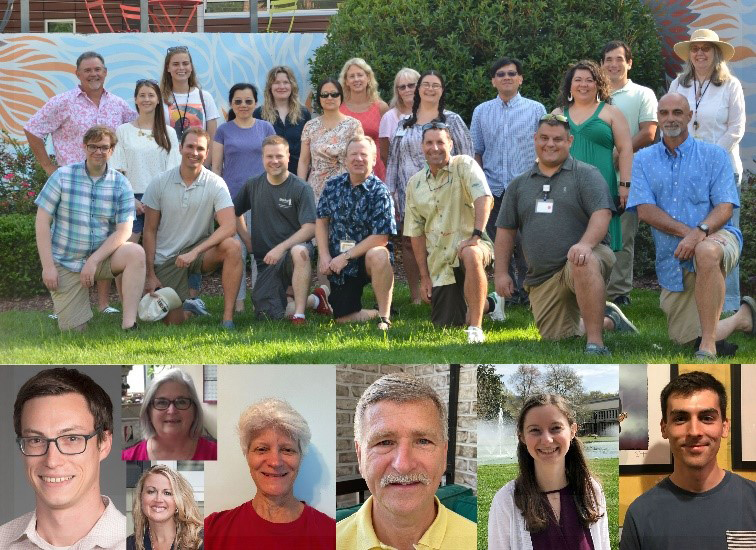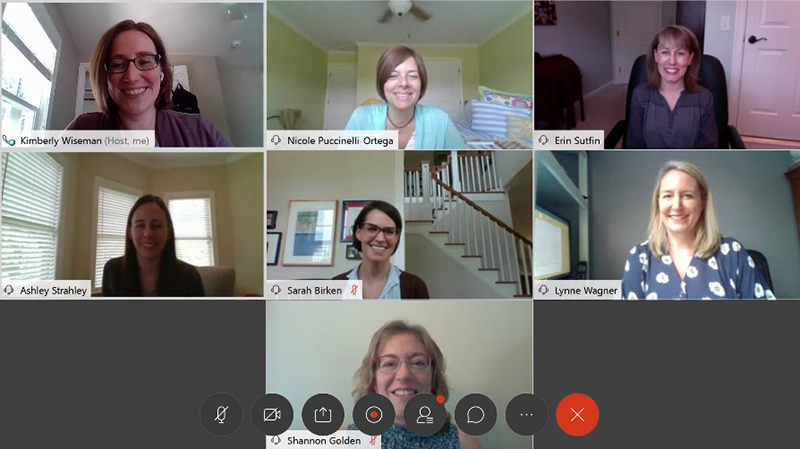2022 Public Health Sciences Top 10 Research Papers
The Division of Public Health Sciences (DPHS) recently announced its top 10 Research Papers of 2022. Papers receiving recognition were selected on the basis of originality and scientific impact. The papers span the spectrum of research, conducted in the DPHS, including clinical trials, epidemiology, implementation science, health policy and community engagement. The top 10 papers further demonstrate the Division’s commitment to improving the health of community, region and nation by utilizing rigorous methodologic approaches to evaluate a broad range of research questions.
Please join us in congratulating this year’s awardees.
- Statins and Left Ventricular Ejection Fraction Following Doxorubicin Treatment
- Altered default mode network associated with pesticide exposure in Latinx children from rural farmworker families.
- Effects of cocoa extract and a multivitamin on cognitive function: A randomized clinical trial.
- Impact of Covid-19 Pandemic on Diabetes Care among a North Carolina Patient Population.
- Increasing access to organization theories for implementation science.
- The Total Nutrient Index is a Useful Measure for Assessing Total Micronutrient Exposures among US Adults.
- Longer-Term All-Cause and Cardiovascular Mortality with Intensive Blood Pressure Control: A Secondary Analysis of a Randomized Clinical Trial.
- Differences in patient outcomes after outpatient GI endoscopy across settings: a statewide matched cohort study.
- Adapting a Group-Level PrEP Promotion Intervention Trial for Transgender Latinas during the COVID-19 Pandemic.
- Racial/Ethnic and Geographic Trends in Combined Stimulant/Opioid Overdoses, 2007-2019.
Protocol for a randomized controlled feasibility study of a coordinated parent/child weight loss intervention: Dyad Plus
Winter 2022
The prevalence of overweight and obesity in youth is emerging as a global health concern, necessitating clinical interventions to treat obesity through promotion of lifestyle modification. Our team is focused on developing strategies to enhance effectiveness of clinical interventions, especially those targeting adolescents who have the highest rates of obesity and dropout from treatment. Targeting family members to treat obesity in youth can be an effective approach, but adherence to family treatment can be sub-optimal despite research suggesting that parent-child interventions can be more effective than treatment programs that focus primarily on the child. We have developed a coordinated care model to assess the feasibility, acceptability, and effectiveness relative to standard care. This model leverages two successful weight loss programs administered at Atrium Health Wake Forest Baptist: Brenner Families in Training (Brenner FIT) and By Design. Brenner FIT is a family-based pediatric weight management clinic for youth with overweight or obesity. By Design is an adult weight loss clinic that includes tailored dietary and physical activity behavioral counseling. Most adolescent youth who enroll in Brenner FIT have at least one adult caregiver who is eligible and would benefit from enrollment in By Design. Therefore, we developed a coordinated program (Dyad Plus), a theoretically based, coordinated approach designed to facilitate self-monitoring, positive communication, joint problem solving, and social support to increase physical activity, healthy eating, and weight loss relative to a non-coordinated approach or Brenner FIT alone. We are currently assessing the acceptability and feasibility of this approach, and despite COVID-19 related challenges, our experience to date suggest that Dyad Plus may be a promising approach for treatment of adolescents with overweight and obesity. Find more information.

EoE Tooth Fairy Study
Fall 2021

Eosinophilic gastrointestinal diseases (EGIDs) include eosinophilic esophagitis (EoE), gastritis, gastroenteritis, and colitis. These conditions are chronic and can have a profound impact on quality of life.For example, children can experience an intolerance to food and, ultimately, failure to thrive. Elizabeth Jensen, MPH, PhD, Associate Professor, Department of Epidemiology and Prevention, has been studying etiologic factors in the development of EGIDs, finding evidence that early life factors, in particular antibiotic use, may be associated with development of these conditions. Dr. Jensen, together and UNC collaborator, Dr. Evan Dellon, are conducting the EoE Tooth Fairy Study, which will recruit children with and without EoE. Baby teeth (saved for the tooth fairy!) will be obtained for study as they provide a signature of exposures in early life such as antibiotic use, breastmilk, infant formula, and solid foods.These patterns can be measured by microspatial analyses as shown in the figure. While studying these uncommon conditions is challenging, the potential rewards are great, with these studies providing some of the earliest clues on how and why these conditions may be increasing.
Investigators include: Carl Langefeld, PhD, Professor, Department of Biostatistics and Data Science, Tim Howard, PhD, Professor, Department of Biochemistry, Anca Safta, MD, Pediatric Gastroenterology, and Angie Almond, Med, RD, Tooth Fairy Study Project Manager, Department of Pediatrics.
MoTrPAC
August 2021
MoTrPAC (The Molecular Transducers of Physical Activity Consortium) is a national research consortium designed to discover and perform preliminary characterization of the range of molecular transducers (the "molecular map") that underlie the effects of exercise in humans. The program's goal is to study the molecular changes that occur during and shortly after exercise and their role in health across the lifespan. The program is the largest targeted NIH investment of funds into the mechanisms of how physical activity improves health and prevents disease.
Members of the Department of Biostatistics and Data Science comprise the Data Management, Analysis, and Quality Control (DMAQC) Center as part of the Consortium Coordinating Center (CCC). The DMAQC manages data, operations, and analyses for 3 Pre-Clinical Animal Sites, 11 Chemical Analysis Sites, 10 adult Clinical Sites, and 1 pediatric Clinical Site. They also collaborate with the MoTrPAC Bioinformatics Center at Stanford and partners in the CCC at the Administrative Coordinating Center at the University of Florida (Pahor, MPI), the Central Biorepository at the University of Vermont (Tracy, MPI), and the Exercise Intervention Core (Rejeski, MPI) at the Wake Forest University Reynolda campus. For the BDS Coordinating Center team, working in this multi-disciplinary environment has brought challenges in terms of new terminology, new technology and complex data tracking challenges, but also led to a strong sense of teamwork and bonding to overcome challenges and open new avenues of research and discovery.

WFSM Study Team: Mike Miller (MPI),Jack Rejeski (MPI), Andrea Anderson, Jerry Barnes, Kate Boyer, Sarah Bruschi, Haiying Chen, Shyh-Huei Chen, Delilah Cook, Fang-Chi Hsu, Julie Hu, Laura Lovato, John Nichols, June Pierce, Eric Reynolds, Joe Rigdon, Scott Rushing, Santiago Saldana, Courtney Simmons, Debbie Steinberg, Cindy Stowe, Shannon Suggs, Jennifer Talton, Mike Walkup, Christopher Webb, Jack White, Barb Nicklas, Tony Marsh, and Jason Fanning.
Identifying Genes that Increase Alzheimer's Disease Risk among Families with African Ancestry
May 2021
Alzheimer’s disease (AD) is the leading cause of dementia and the sixth-leading cause of death in the United States. African Americans (AA) have a risk two times greater than non-Hispanic Whites (NHW). Unfortunately, AA remain underrepresented in most research studies and particularly in AD genetic studies. Understanding genetic factors of AD risk in AAs is a national priority given the increased risk and lower levels of research participation in this population. This study, entitled Replication and Extension of Alzheimer Disease Sequencing Project Discoveries in African-Americans, is a component of the national Alzheimer Disease Sequencing Project and is designed to increase our knowledge about genetic variation, particularly for rare variants that either increase or decrease the risk of developing AD in families with African ancestry. The set of genes and loci discovered in this study may point to pathways and mechanisms that avail themselves to therapeutic intervention and new strategies for prevention. This is a multi-site collaboration with investigators at the University of Miami, Columbia University and Case Western Reserve University.

WFBH Study Team: Goldie S. Byrd, PhD; Allison Caban-Holt, PhD; and Takiyah D. Starks, MS.
Qualitative and Patient-Reported Outcomes Shared Resource (Q-PRO)
February 2021
The primary goal of the Qualitative and Patient Reported Outcomes (Q-PRO) Shared Resource is to collaborate with and support Wake Forest Baptist Comprehensive Cancer Center and the Wake Forest School of Medicine community by providing expertise, consultation, and mentoring for research protocols that use qualitative designs and/or PRO measurement to enhance peer-reviewed cancer-focused research. Q-PRO provides investigators with state-of-the art methods for conducting qualitative research and provides expert guidance on PRO design.

Q-PRO Team : PIs. Erin Sutfin, PhD and Lynne Wagner, PhD, Sarah Birken, PhD, Nicole Puccinelli-Ortega, Kimberly Wiseman, Shannon Golden, and Ashley Strahley
PREVENTABLE
November 2020
PREVENTABLE (PRagmatic EValuation of evENTs And Benefits of Lipid-lowering in oldEr adults) is a 20,000-subject randomized trial funded by the National Institute of Aging that will examine the overall benefits and risks of cholesterol-lowering drugs known as statins in adults age 75 or older without cardiovascular disease. The trial will help determine whether a statin can help prevent dementia and disability in this age group, as well as heart attacks and other cardiovascular-related deaths, while not increasing risks of adverse health outcomes.
Wake Forest University School of Medicine houses two components of PREVENTABLE. The data coordinating center is housed within PHS and the Geriatric Assessment Center is housed in Geriatrics. WFSM is partnering with Duke University, which will house the Clinical Coordinating Center; the Boston V; the VA Cooperative Studies Pharmacy; and PCORnet to conduct this study.
 PREVENTABLE Study Team including PHS team members: PI, Walter Ambrosius, PhD, Nicholas Pajewski, PhD, David Reboussin, PhD, Janet Davis and Letitia Perdue
PREVENTABLE Study Team including PHS team members: PI, Walter Ambrosius, PhD, Nicholas Pajewski, PhD, David Reboussin, PhD, Janet Davis and Letitia Perdue
Evaluating the Impact of Waterpipe Tobacco Marketing Claims on Young Adults
May 2020
In 2019, the NCI and FDA Center for Tobacco Products funded Erin Sutfin, PhD, and her team’s R01 Evaluating the Impact of Waterpipe Tobacco Marketing Claims on Young Adults. Waterpipe tobacco (WT) smoking is common among young adults in the U.S. Despite significant health effects associated with waterpipe tobacco smoking, young adults erroneously believe WT smoking is less harmful and less addictive than cigarette smoking. Marketing, including package design and digital marketing (websites and social media), is an effective tool used by the tobacco industry to communicate product health information to consumers. The common use of fruit imagery and text describing the quality of the tobacco may be associated with reduced harm perceptions.
 The FDA has begun to prohibit certain claims on WT packaging and in marketing. Some prohibited claims are easily identifiable, but others are more difficult to identify due to lack of specificity in the law and the implicit nature of some claims. Evidence is needed, specific to WT packaging and marketing, to identify claims and determine their influence on consumer harm misperceptions to inform future regulatory actions. This study will address this gap by documenting claims on WT packaging and in digital marketing and identifying how such claims influence consumer perceptions. The findings will help the FDA determine which claims consumers interpret in ways that the law prohibits, which could prompt the FDA to engage in additional rulemaking so consumers are not misled.
The FDA has begun to prohibit certain claims on WT packaging and in marketing. Some prohibited claims are easily identifiable, but others are more difficult to identify due to lack of specificity in the law and the implicit nature of some claims. Evidence is needed, specific to WT packaging and marketing, to identify claims and determine their influence on consumer harm misperceptions to inform future regulatory actions. This study will address this gap by documenting claims on WT packaging and in digital marketing and identifying how such claims influence consumer perceptions. The findings will help the FDA determine which claims consumers interpret in ways that the law prohibits, which could prompt the FDA to engage in additional rulemaking so consumers are not misled.
Study Team: Erin Sutfin, PhD; Jennifer Ross, PhD; Kimberly Wagoner, DrPH, MPH; Beth Reboussin, PhD; Caroline Kimes, BS; Bobby Amoroso, BS; Cindy Suerken, MS; Eric Soule, PhD, Eastern Carolina University; Alison Lazard, PhD, University of North Carolina; Desmond Jenson, JD, Public Health Law Center
SEARCH Study
February 2020
The SEARCH for Diabetes in Youth (SEARCH) study was initiated in 2000 and has been funded for 20 years with funding to address major knowledge gaps in the understanding of childhood diabetes. Wake Forest serves as the data coordinating center for the SEARCH study providing scientific support for protocol development, statistical analysis and data management. The CDC provides funding for the SEARCH Registry Study, which is a study of the incidence and prevalence of type 1 diabetes and type 2 diabetes in youth occurring over the past two decades in five geographically distinct locations of the U.S. and represents the largest, most diverse study of diabetes among U.S. youth.
We observed that the incidence of both type 1 and type 2 diabetes increased significantly over this period, particularly among youths of minority racial and ethnic groups. The NIDDK provides funding for the SEARCH Cohort Study, which has followed, longitudinally, a cohort of children since their diagnosis with either type 1 or type 2 diabetes. These children are now young adults and they are at the stage of life where they are developing complications of diabetes. We measured diabetic kidney disease, retinopathy, peripheral neuropathy, cardiovascular autonomic neuropathy, arterial stiffness and hypertension in more than 2,000 youth with diabetes.
 Study Team: Ralph D’Agostino, Jr, PhD, Lynne Wagenknecht, DrPH, Elizabeth Jensen, PhD, Jasmin Divers, PhD, Andrew South, MD, Beth Reboussin, PhD, Brian Wells, PhD, Ramon Casanova, PhD, Leora Henkin, Carrie Williams, Maureen Goldstein, Jennette Stafford, Scott Isom, Cindy Seurken, Kristin Lenoir, Jerry Barnes, Ken Wilson, John Hepler, June Pierce, Julia Spell, Danielle Cunio, Rhonda Blaine, James Lovato
Study Team: Ralph D’Agostino, Jr, PhD, Lynne Wagenknecht, DrPH, Elizabeth Jensen, PhD, Jasmin Divers, PhD, Andrew South, MD, Beth Reboussin, PhD, Brian Wells, PhD, Ramon Casanova, PhD, Leora Henkin, Carrie Williams, Maureen Goldstein, Jennette Stafford, Scott Isom, Cindy Seurken, Kristin Lenoir, Jerry Barnes, Ken Wilson, John Hepler, June Pierce, Julia Spell, Danielle Cunio, Rhonda Blaine, James Lovato
NCI Community Oncology Research Program (NCORP)
November 2019
 The NCI Community Oncology Research Program (NCORP) was launched in 2014 to ensure that people can participate in clinical trials focused on cancer control, prevention and care delivery, regardless of where they live. The Wake Forest NCORP Research Base is one of seven research bases funded by the NCI to develop and implement cancer prevention and control research for the NCORP community oncology research network. We partner with NCORP Sites across the country to test new approaches to cancer care delivery and the treatment, prevention and detection of cancer-related symptoms. Our goal is to conduct practice-changing cancer research that will improve patient outcomes. Our studies are designed to be easy to implement and manage. Almost without exception, we will provide drugs for the study at no cost to the patient and limit any follow up to that which is relevant to the study.
The NCI Community Oncology Research Program (NCORP) was launched in 2014 to ensure that people can participate in clinical trials focused on cancer control, prevention and care delivery, regardless of where they live. The Wake Forest NCORP Research Base is one of seven research bases funded by the NCI to develop and implement cancer prevention and control research for the NCORP community oncology research network. We partner with NCORP Sites across the country to test new approaches to cancer care delivery and the treatment, prevention and detection of cancer-related symptoms. Our goal is to conduct practice-changing cancer research that will improve patient outcomes. Our studies are designed to be easy to implement and manage. Almost without exception, we will provide drugs for the study at no cost to the patient and limit any follow up to that which is relevant to the study.

For the second time in five years, the Wake Forest NCORP has been recognized by the NCI and has been granted a six-year $25 million award that will build on the previous work done through an $18 million award received in 2014. The grant is designed to focus on extending ongoing clinical research in cardiovascular and neurocognitive complications of cancer treatments and on improving patient well-being during cancer care.
Led by Glenn Lesser, MD, and Kathryn Weaver, PhD. WFSM study team: Karen Craver, Ruth Wright, Renee Glenn, Jenna Gerosa, Bill Stanfield, Eden Gurganus, Cissy Yates, Rhonda Kimball, Dell Campbell, Scarlett Hutchens, Tanny Vogler, Julie Turner, June Fletcher-Steede
Action for Health in Diabetes (Look AHEAD) Study

August 2019
The Action for Health in Diabetes (Look AHEAD) Study is a randomized trial of 5,145 participants comparing the effects of Intensive Lifestyle Intervention (ILI) focused on weight loss achieved through healthy eating and increased physical activity versus a control condition of Diabetes Support and Education (DSE) in overweight and obese individuals with type 2 diabetes. The intervention phase of the trial ended in 2012 at which time it was determined that the intervention had no effect on the primary outcome of heart disease. We are now in the 20th year of the study, which is referred to as the Look AHEAD Extension (LA-E). The goal of LA-E is to examine whether ILI, provided for 10 years during mid-life, has enduring benefits that persist beyond the period of the intervention for older individuals with diabetes.
LA-E focuses on the clinical outcomes most relevant to healthy aging and resilience and will provide the long-term data needed to frame guidelines related to lifestyle intervention in the care of older overweight or obese individuals with type 2 diabetes. Outcomes in LA-E include mortality, health care costs, frailty, microvascular complications of diabetes (eye, kidney and nerve) and quality of life.
Wake Forest Division of Public Health Sciences serves as the data coordinating center. An important strength of the study is our spirit of collaboration. Within our institution, collaborating departments over the years have included cardiology, neurology, geriatrics, and health adn exercise science on the Reynolda Campus.
Led by Mark Espeland and Lynne Wagenknecht, the WFSM study team includes: Andrea Anderson, Judy Bahnson, Michael Bancks, Jerry Barnes, Mary Barr, Patricia Beatty, Tara Beckner, Peter Brubaker, Haiying Chen, Delilah Cook, Katelyn Garcia, Sarah Gaussoin, Kate Hayden, Lea Harvin, Denise Houston, Rebecca Neiberg, Nick Pajewski, June Pierce, David Reboussin, Jack Rejeski, Debbie Steinberg, Michael Walkup, Christopher Webb, and Carrie Williams.
MILES Study
May 2019
Microbiome and Insulin Longitudinal Evaluation Study (MILES) is a collaboration between Cedars-Sinai (Mark Goodarzi, project PI) and Wake Forest School of Medicine (Alain Bertoni field center PI and Elizabeth Jensen Co-I), LABiomed, Baylor College of Medicine and University of Virginia. This 30-month observational study is investigating the relationship between organisms that live in the gastro-intestinal (GI) track and glucose metabolism. The study has just finished up the recruitment stage. Enrollment has exceeded the expected target of 300 Non-Hispanic white and African American men and women between the ages of 40-85. There are thought to be links between the foods one eats, the gut and microorganisms that live there, levels of the hormone insulin, and glucose, the main sugar that provides energy for the body to function. Data will be collected at 3 time points on non-diabetic participants over three years to better understand why some people develop type 2 diabetes.
The aims are as follows:
- Specific Aim 1: Characterize the change in the insulin axis (insulin sensitivity, secretion, clearance) and characterize metabolic homeostasis in two race/ethnic groups (White and African American) by performing an oral glucose challenge at three clinic visits over 30 months.
- Specific Aim 2: Determine the gut microbiota composition at each visit, specifically organisms that produce short chain fatty acids (SCFA). We will estimate the effect of the gut microbiota (our primary predictor) on the insulin axis (insulin sensitivity, insulin secretion, and insulin clearance), alone and jointly with habitual diet, in two race/ethnic groups.
- Specific Aim 3: Establish microbial functions that determine changes over time in the insulin axis in the context of the gut microbiota, habitual diet, and circulating SCFA levels (as an effect modifier).
Led by Principal Investigator Alain Bertoni and co-investigator, Elizabeth Jensen, the Wake Forest team includes: Lenore Crago, Mary Kelsey Trumps, Rosalia Arnolda, Katlyn Hodges, Joey Curran.
WHISPER
January 2019
We all know sleep is important. But how does sleep actually affect our overall health as we age? And what if there was a simple tool we could use to identify a potential invention to avoid negative health outcomes? Unfortunately, for postmenopausal women in particular, these questions go unanswered. Laura Baker, PhD (Gerontology & Geriatric Medicine and Social Sciences & Health Policy) and her team in Public Health Sciences are tackling these questions with the WHISPER (Women’s Health Initiative Sleep hyPoxia Effects on Resilience) Study.
 WHISPER examines the role of nocturnal intermittent hypoxia and other adverse sleep exposures on cardiovascular events and progression, cancer incidence and severity and cognitive trajectory, including risk of mild cognitive impairment (MCI), Alzheimer’s disease (AD) and related dementias in older women from the Women’s Health Initiative Extension Study cohort. Dr. Baker’s team serves as the study’s coordinating center, in collaboration with Harvard University, California Pacific Medical Center, Stanford University, the Fred Hutchinson Cancer Research Center and the University of North Carolina-Chapel Hill. Funding is from the NIH/NHLBI.
WHISPER examines the role of nocturnal intermittent hypoxia and other adverse sleep exposures on cardiovascular events and progression, cancer incidence and severity and cognitive trajectory, including risk of mild cognitive impairment (MCI), Alzheimer’s disease (AD) and related dementias in older women from the Women’s Health Initiative Extension Study cohort. Dr. Baker’s team serves as the study’s coordinating center, in collaboration with Harvard University, California Pacific Medical Center, Stanford University, the Fred Hutchinson Cancer Research Center and the University of North Carolina-Chapel Hill. Funding is from the NIH/NHLBI.
WHISPER is currently in the process of enrolling 5,000 postmenopausal women across the U.S. to complete a one-time sleep assessment using two at-home, low cost, wristworn devices: the Itamar WatchPAT (to measure oximetry for one night) and the ActiLife Actigraph (to measure actigraphy for four days and four nights). Both devices have been validated to provide reliable estimates of sleep-disordered breathing (WatchPAT) and sleep duration/variation (Actigraph)—which have been identified as risk factors for negative health outcomes.
A unique aspect of WHISPER is that participants do not report to a clinic site to receive and be trained in the use of the sleep assessment devices. Instead, devices are mailed to the participants from the WHISPER offices in 525@vine and devices are returned by mail where the sleep data are downloaded for analysis. Enrolled participants receive a shipment including pictorial instruction cards, a self-report sleep diary, and the two wrist worn sleep devices. Participants receive phone calls throughout the sleep assessment to discuss the instructions and to be interviewed.
The results of this study have the potential to impact routine clinical care by providing an alternative cost-efficient, low burden, home-based sleep assessment for patients at highest risk for cardiovascular disease, cancer, and cognitive impairment.
Led by Principal Investigator Dr. Laura Baker, the WFSM study team includes: Dan Beavers, Steve Rapp, David Reboussin, Sally Shumaker, Bev Snively, Bonnie Sachs, Alyssa Anderson, Mark Brown, Lynn Callahan, Danielle Cunio, Heather Dailey, Jonna Daniel, Brittany Davis, Sharnita Duren, Ann Furstenburg, Leslie Gordineer, Darrin Harris, Leonard Jordan, Deb Kampman, Margaret Pearce, Debbie Pleasants, Julia Robertson, Margaret Scales, Cheryl Summerville.
